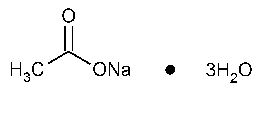Sodium Acetate
Acetic acid,sodium salt,trihydrate.
Sodium acetate trihydrate [6131-90-4].
Anhydrous 82.03 [127-09-3].
»Sodium Acetate contains three molecules of water of hydration,or is anhydrous.It contains not less than 99.0percent and not more than 101.0percent of C2H3NaO2,calculated on the dried basis.
Packaging and storage—
Preserve in tight containers.
Labeling—
Label it to indicate whether it is the trihydrate or is anhydrous.Where Sodium Acetate is intended for use in hemodialysis,it is so labeled.
pHá791ñ:
between 7.5and 9.2,in a solution in carbon dioxide-free water containing the equivalent of 30mg of anhydrous sodium acetate per mL.
Loss on drying á731ñ—
Dry at 120 to constant weight:the hydrous form loses between 38.0%and 41.0%of its weight,and the anhydrous form loses not more than 1.0%of its weight.
to constant weight:the hydrous form loses between 38.0%and 41.0%of its weight,and the anhydrous form loses not more than 1.0%of its weight.
Insoluble matter—
Dissolve the equivalent of 20g of anhydrous sodium acetate in 150mLof water,heat to boiling,and digest in a covered beaker on a steam bath for 1hour.Filter through a tared filtering crucible,wash thoroughly,and dry at 105 :the weight of the residue does not exceed 10mg (0.05%).
:the weight of the residue does not exceed 10mg (0.05%).
Chloride á221ñ—
Aportion equivalent to 1.0g of anhydrous sodium acetate shows no more chloride than corresponds to 0.50mLof 0.020Nhydrochloric acid (0.035%).
Sulfate á221ñ—
Aportion equivalent to 10g of anhydrous sodium acetate shows no more sulfate than corresponds to 0.50mLof 0.020Nsulfuric acid (0.005%).
Calcium and magnesium—
To 20mLof a solution containing the equivalent of 10mg of anhydrous sodium acetate per mLadd 2mLeach of 6Nammonium hydroxide,ammonium oxalate TS,and dibasic sodium phosphate TS:no turbidity is produced within 5minutes.
Potassium—
Dissolve the equivalent of 3g of anhydrous sodium acetate in 5mLof water,add 1Nacetic acid dropwise until the solution is slightly acidic,and then add 5drops of sodium cobaltinitrite TS:no precipitate is formed.
Aluminum á206ñ(where it is labeled as intended for use in hemodialysis)—
Proceed as directed using 10.0g of Sodium Acetate to prepare theTest Preparation:the limit is 0.2µg per g.
Heavy metals,Method Iá231ñ—
Dissolve a portion equivalent to 4.2g of C2H3NaO2in enough water to make 50mLof stock solution.Transfer 12mLof this stock solution to a 50-mLcolor-comparison tube (Test Preparation).Transfer 11mLof the stock solution to a second color-comparison tube containing 1.0mLofStandard Lead Solution (Monitor Preparation).Transfer 1.0mLofStandard Lead Solution and 11mLof water to a third color-comparison tube (Standard Preparation).Proceed as directed forProcedure,omitting the dilution to 50mL:the limit is 0.001%.
Organic volatile impurities,Method IVá467ñ:
meets the requirements.
Assay—
Weigh accurately the equivalent of about 200mg of anhydrous sodium acetate,and dissolve in 25mLof glacial acetic acid,warming gently if necessary to effect complete solution.Add 2drops ofp-naphtholbenzein TS,and titrate with 0.1Nperchloric acid VS.Perform a blank determination,and make any necessary correction.Each mLof 0.1Nperchloric acid is equivalent to 8.203mg of C2H3NaO2.
Auxiliary Information—
Staff Liaison:Karen A Russo,Ph.D.,Scientist
Expert Committee:(PA1)Pharmaceutical Analysis 1
USP28–NF23Page 1774
Pharmacopeial Forum:Volume No.29(5)Page 1576
Phone Number:1-301-816-8379
